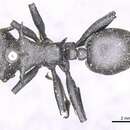tr
kırıntılardaki isimler


Taxonomic history
De Andrade & Baroni Urbani, 1999 PDF: 124 (m.).Combination in Cephalotes: Emery, 1924f PDF: 304; De Andrade & Baroni Urbani, 1999 PDF: 124.Junior synonym of Cephalotes atratus: Klug, 1824 PDF: 200; Smith, 1853 PDF: 215; Smith, 1858a PDF: 188; Roger, 1862c PDF: 291; Mayr, 1863a PDF: 405; Roger, 1863b PDF: 38; Mayr, 1865 PDF: 114; Dalla Torre, 1893 PDF: 141; Forel, 1899b PDF: 48; Emery, 1924f PDF: 304; Borgmeier, 1927c PDF: 114; Kempf, 1972b PDF: 75; Bolton, 1995b: 141.Status as species: De Andrade & Baroni Urbani, 1999 PDF: 124 (redescription); Sandoval-Gómez & Sánchez-Restrepo, 2019 PDF: 912.Senior synonym of Cephalotes decemspinosus: De Andrade & Baroni Urbani, 1999 PDF: 124.Senior synonym of Cephalotes decemspinosus spissus: De Andrade & Baroni Urbani, 1999 PDF: 124.
Cephalotes marginatus is a species of arboreal ant of the genus Cephalotes, characterized by an odd shaped head and the ability to "parachute" by steering their fall if they drop off of the tree they're on. Giving their name also as gliding ants.[1][2] The species is native of the northern half of South America, especially Amazon basin, Ecuador and Colombia.[3] Their larger and flatter legs, a trait common with other members of the genus Cephalotes, gives them their gliding abilities.[4]
The species was first given a description and a classification in 1804 by Danish entomologist Johan Christian Fabricius.
Cephalotes marginatus is a species of arboreal ant of the genus Cephalotes, characterized by an odd shaped head and the ability to "parachute" by steering their fall if they drop off of the tree they're on. Giving their name also as gliding ants. The species is native of the northern half of South America, especially Amazon basin, Ecuador and Colombia. Their larger and flatter legs, a trait common with other members of the genus Cephalotes, gives them their gliding abilities.
The species was first given a description and a classification in 1804 by Danish entomologist Johan Christian Fabricius.